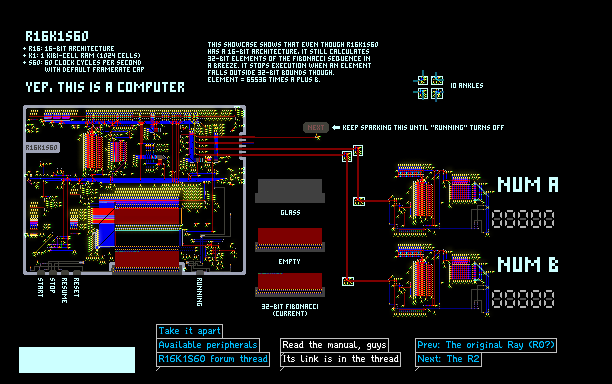R16K1S60 by LBPHacker

*** Update #9: Add links to predecessor and successor *** See thread and manual link in the save. ***
fastest
subframe
programmable
16bit
processor
7segment
electronics
electronic
computer
magic
Comments
-
cmk20 4th Jul 2016
 Neat... that make a lot more sense thanks :)
Neat... that make a lot more sense thanks :) -
LBPHacker 4th Jul 2016
 A few words on the RAM: On a read, a single column of FILT is copied down from the upper chamber to the lower one, where it's hit with a BRAY from the left. This BRAY carries the data to the right where it's stored. On a write every column but one is copied from the upper chamber to the lower one, then a full row of filt is overwritten in the upper chamber by DTEC, but then all the columns get copied back up, leaving only a single column with a single row, thus a single particle, modified.
A few words on the RAM: On a read, a single column of FILT is copied down from the upper chamber to the lower one, where it's hit with a BRAY from the left. This BRAY carries the data to the right where it's stored. On a write every column but one is copied from the upper chamber to the lower one, then a full row of filt is overwritten in the upper chamber by DTEC, but then all the columns get copied back up, leaving only a single column with a single row, thus a single particle, modified. -
LBPHacker 4th Jul 2016
 There's a lot happening in there, most of which you can't even see, and not because they happen too fast. They just happen in a period when nothing is rendered. The simulation is rendered after every frame, but these events begin after a render and end before the next, leaving no trace behind. Pause the simulation, delete parts of the machine and advance the simulation too see what you just deleted should have undone.
There's a lot happening in there, most of which you can't even see, and not because they happen too fast. They just happen in a period when nothing is rendered. The simulation is rendered after every frame, but these events begin after a render and end before the next, leaving no trace behind. Pause the simulation, delete parts of the machine and advance the simulation too see what you just deleted should have undone. -
cmk20 4th Jul 2016
 Subfram tech is so far beyond me... but this is so awsome.... Also im currious how dose the ram store data? It dosent seem to be changeing at all
Subfram tech is so far beyond me... but this is so awsome.... Also im currious how dose the ram store data? It dosent seem to be changeing at all -
Grufkork 23rd Jun 2016
 Idk how this works... BUT IT'S SO FREAKING COOL THAT YOU ACTUALLY FREAKING BUILT A FREAKING COMPUTER THAT FREAKING CALCULATES THE FREAKING FIBONACCI SEQUENCE! +9000
Idk how this works... BUT IT'S SO FREAKING COOL THAT YOU ACTUALLY FREAKING BUILT A FREAKING COMPUTER THAT FREAKING CALCULATES THE FREAKING FIBONACCI SEQUENCE! +9000 -
FunkyPrince 23rd Jun 2016
 Oh loool, sorry then, thanks for the answer tho u.u
Oh loool, sorry then, thanks for the answer tho u.u -
LBPHacker 23rd Jun 2016
 Off Topic: Please read people's biography before you ask about their backgrounds. Hint: no, I've had this name way before LBP arrived.
Off Topic: Please read people's biography before you ask about their backgrounds. Hint: no, I've had this name way before LBP arrived. -
FunkyPrince 22nd Jun 2016
 Off Topic: Does LBP, in your name, stand for LittleBigPlanet?
Off Topic: Does LBP, in your name, stand for LittleBigPlanet? -
00yoshi 21st Jun 2016
 I'm starting to figure it out, behaves strange tho
I'm starting to figure it out, behaves strange tho -
00yoshi 21st Jun 2016
 Hm, let's sww how I can integrate that into the computer I'm building now. This may explain my problems with pistons, thanks for the info.
Hm, let's sww how I can integrate that into the computer I'm building now. This may explain my problems with pistons, thanks for the info.